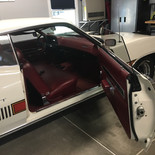A History of Ford in 650 Words or Less
- Chris

- Jun 19, 2019
- 3 min read
Updated: Oct 17, 2019
Ford is the company credited with making motor vehicles accessible to the general public, but did you know it wasn’t always a successful venture? From humble beginnings to its current iconic status, the history of Ford is full of interesting twists and turns.
The Early Years
Henry Ford had built his first automobile, dubbed the “quadracycle,” in 1896 and, after working as a chief engineer at Edison Illumination Company, left to found his first car business in 1899. With the help of a group of investors, he established the Detroit Automobile Company to bring his ideas to market.
The company went under after less than two years. Undeterred, Ford and his investors founded the Henry Ford Company in 1901, but it failed, too, and was later transformed by others and into the Cadillac Motor Company. 1903 saw the establishment of the now-famous Ford Motor Company. With just $28,000, around $813,000 in today’s money, Ford finally put together a successful venture and began producing some of the most well-known cars in history.
Take a look at some of the Ford vehicles we've cleaned over the years!
Popularity and Expansion
By the time the first Model A appeared during Ford’s first year of operation, the company has used up nearly all of its startup money. However, the car proved to be so popular that it only took a few months to start bringing in profits. From there, Ford produced a series of cars named sequentially by letter and invented the first mass assembly line to meet public demand.
The Model T hit the market in 1908 and continued production until 1927, during which time 15 million of the cars were sold. Because the price was much more affordable than other vehicles, working-class people were able to start enjoying a luxury once reserved for the rich. However, Ford did still make forays into the luxury market when it acquired the Lincoln Motor Company in 1922 and started producing higher-end models.
By the end of the 1920s, Ford had expanded overseas with assembly factories in Asia, Australia, Canada, Europe, Latin America and South Africa. Throughout both World Wars, the company remained a prominent fixture and produced cars and other vehicles for military use.
Ownership Changes
Following a shakeup with stockholders in 1919, Edsel Ford became president of the company until his death in 1943, after which Henry Ford returned to the helm. During Edsel’s tenure, the company saw a brief period of slow sales and was temporarily shut down. However, Edsel recognized the demand for mid-priced luxury cars and began producing new models to appeal to the market. (It’s interesting to note the car bearing his name, known for being a terrible flop, wasn’t actually produced until 14 years after his death.)
When Henry Ford Himself died in 1947, Henry Ford II took over the company, fixed up some messy problems with its finances and continued to oversee it until 1980.
Moving Forward and Pulling Back
Many classic Ford models appeared between the 1940s and 1960s, including the F-1 truck, the Thunderbird and the Mustang. Between 1979 and 2000, Ford expanded by acquiring several other brands, including Aston Martin, Jaguar, Land Rover and Volvo. However, these acquisitions were short-lived. When the recession hit the U.S. economy in the late 2000s, the company sold off several brands and started paring down production to reduce operating costs. Due to these strategic moves, Ford was the only one of the Big Three automakers to avoid filing for bankruptcy and didn’t require any government bailout funding to stay afloat.
Today, Ford has narrowed its focus to SUVs, crossover vehicles and its signature rugged pickup trucks. Although the company looks very different now than when it cranked out the first Model A, Ford continues to stand as an example of innovation and ingenuity in the automobile industry.
About the Author
Theresa “Sam” Houghton is a writer, speaker and health coach from Troy, NY. She’s a regular contributor to NutritionStudies.org, and her work has appeared in the Honest Weight Food Co-Op Coop Scoop, Natural Awakenings Magazine and the NutritionFacts.org 2017 Daily Dozen calendar. She has been a featured guest on Focus on Albany, WMAC’s Food Friday and the Just Ask David podcast. When she's not writing or cooking, Sam likes to read and study the Bible, cook tasty plant-based food and knit socks.You can find out more about Sam at GreenGutWellness.com.

.png)






































































































































Comments